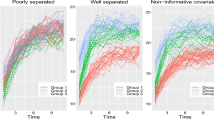Abstract
This paper considers a finite mixture model for longitudinal data, which can be used to study the dependency of the shape of the respective follow-up curves on treatments or other influential factors and to classify these curves. An EM-algorithm to achieve the ml-estimate of the model is given. The potencies of the model are demonstrated using data of a clinical trial.
Similar content being viewed by others
References
Böhning, D., Schlattmann, P., and B. Lindsay (1992) Computer Assisted Analysis of Mixtures (C.A.MAN): Statistical Algorithms.Biometrics, 48, 283–303
Dempster, A.P., Laird, N.M., and D.B. Rubin (1977) Maximum likelihood estimation from incomplete data via the EM algorithm (with discussion).J. Roy. Statist. Soc. B, 39, 1–39.
Dietz, E. (1992) Estimation of heterogeneity—a GLM-approach,Fahrmeir, L., Francis, B., Gilchrist, R. Tutz, G. (Eds.):Advances in GLIM and Statistical Modelling. Lecture Notes in Statistics, 78, 66–71. Springer, New York.
Follmann, D.A. and D. Lambert (1991) Indentifiability of finite mixtures of logistic regression models.J. Statist. Planning and Inference, 27, 375–381.
Lambert, D. (1992) Zero-inflated poisson regression, with an application to defects in manufacturing.Technometrics, 34, 1–14.
Leroux, B.G. and M.L. Puterman (1992) Maximum-penalized-likelihood estimation for independent and Markov-dependent mixture distribution.Biometrics, 48, 545–558.
Little, R.J.A. and D.B. Rubin (1983) On jointly estimating parameters and missing values by maximizing the complete data likelihood.Amer. Statist., 37, 218–220
McLachlan, G.J. and K.E. Basford (1988)Mixture models: Inference and Applications to Clustering. Marcel Dekker, New York.
Titterington, D.M., Smith, A.F.M. and U.E. Makov (1985)Statistical Analysis of Finite Mixture Distributions. Wiley, London.
White, H. (1982) Maximum likelihood estimation of misspecified models.Econometrica, 50, 1–25.
Zeger, S.L., Liang, K.-Y. and P.S. Albert (1988) Models for longitudinal data: a generalized estimating equation approach.Biometrics, 44, 1049–1060.
Author information
Authors and Affiliations
Rights and permissions
About this article
Cite this article
Dietz, E., Böhning, D. Analysis of longitudinal data using a finite mixture model. Statistical Papers 35, 203–210 (1994). https://doi.org/10.1007/BF02926414
Received:
Revised:
Issue Date:
DOI: https://doi.org/10.1007/BF02926414




